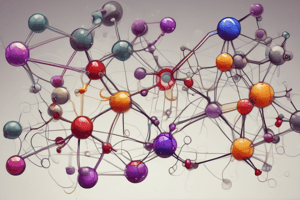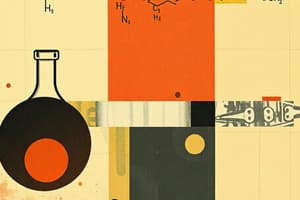Podcast
Questions and Answers
What defines a rearrangement reaction?
What defines a rearrangement reaction?
- A chemical reaction that creates a polymer.
- Two molecules exchange parts during the reaction.
- The carbon skeleton of a molecule is rearranged. (correct)
- A functional group is replaced by another group.
During a substitution reaction, what typically occurs at the carbon atom?
During a substitution reaction, what typically occurs at the carbon atom?
- An isomerization takes place.
- A new carbon-carbon bond is formed.
- The carbon atom undergoes oxidation.
- One sigma bond breaks and another forms. (correct)
Which statement accurately describes isomers?
Which statement accurately describes isomers?
- Isomers cannot exist in the same chemical reactions.
- All isomers are structural isomers.
- Isomers have the same molecular formula but different arrangements. (correct)
- Isomers have different molecular formulas.
What is the most common example of a substitution reaction?
What is the most common example of a substitution reaction?
In substitution reactions, what type of atom is typically replaced?
In substitution reactions, what type of atom is typically replaced?
What is the primary purpose of the reaction arrow in organic equations?
What is the primary purpose of the reaction arrow in organic equations?
Which of the following best describes an addition reaction?
Which of the following best describes an addition reaction?
In the context of addition reactions, what happens during the addition of HX to an alkene?
In the context of addition reactions, what happens during the addition of HX to an alkene?
What notation is used to signify that a reaction requires heat?
What notation is used to signify that a reaction requires heat?
How are sequential reactions typically represented in organic chemistry?
How are sequential reactions typically represented in organic chemistry?
Which of the following correctly describes the products of the addition of Br2 to an alkene?
Which of the following correctly describes the products of the addition of Br2 to an alkene?
Which statement about solvents in organic reactions is true?
Which statement about solvents in organic reactions is true?
What is formed when an alkene undergoes hydration?
What is formed when an alkene undergoes hydration?
According to Markovnikov's Rule, which describes the addition of HBr to an alkene, where does the hydrogen atom attach?
According to Markovnikov's Rule, which describes the addition of HBr to an alkene, where does the hydrogen atom attach?
Which catalyst is needed for the chlorination of benzene?
Which catalyst is needed for the chlorination of benzene?
What type of catalyst is used when adding H2 to alkynes to produce cis alkenes?
What type of catalyst is used when adding H2 to alkynes to produce cis alkenes?
What is the outcome of the elimination reaction involving dehydration of ethanol with an acid catalyst?
What is the outcome of the elimination reaction involving dehydration of ethanol with an acid catalyst?
What is replaced in benzene during the sulfonation reaction?
What is replaced in benzene during the sulfonation reaction?
Which group acts as a meta-directing group in aromatic substitution?
Which group acts as a meta-directing group in aromatic substitution?
How does the addition of bromine to alkynes typically proceeds initially?
How does the addition of bromine to alkynes typically proceeds initially?
Which of the following substitutions requires H2SO4 as a catalyst?
Which of the following substitutions requires H2SO4 as a catalyst?
What happens in elimination reactions when X and Y groups are removed from the starting material?
What happens in elimination reactions when X and Y groups are removed from the starting material?
During an elimination process, what type of bonding occurs between adjacent atoms?
During an elimination process, what type of bonding occurs between adjacent atoms?
During the nitration of benzene, which group is introduced?
During the nitration of benzene, which group is introduced?
Which reaction replaces an H atom with a nitro group from HNO3?
Which reaction replaces an H atom with a nitro group from HNO3?
In a reaction where the dehydrogenation of 2-methylpropane occurs, what product is formed?
In a reaction where the dehydrogenation of 2-methylpropane occurs, what product is formed?
In the halogenation of benzene, which halogen is specifically mentioned?
In the halogenation of benzene, which halogen is specifically mentioned?
What type of directing group is –OH classified as in aromatic substitution?
What type of directing group is –OH classified as in aromatic substitution?
Flashcards
Addition Reaction
Addition Reaction
Molecules combine to form a larger molecule, common in compounds with multiple bonds.
Elimination Reaction
Elimination Reaction
A molecule splits into two smaller molecules, often involving the loss of hydrogen.
Rearrangement Reaction
Rearrangement Reaction
Atoms rearrange within a molecule, forming a structural isomer.
Substitution Reaction
Substitution Reaction
Signup and view all the flashcards
Halogen Addition to Alkenes
Halogen Addition to Alkenes
Signup and view all the flashcards
Addition of HX to Alkenes
Addition of HX to Alkenes
Signup and view all the flashcards
Addition of H2O to Alkenes (Hydration)
Addition of H2O to Alkenes (Hydration)
Signup and view all the flashcards
H2 Addition to Alkynes (Lindlar)
H2 Addition to Alkynes (Lindlar)
Signup and view all the flashcards
Dehydration Reaction
Dehydration Reaction
Signup and view all the flashcards
Dehydrogenation Reaction
Dehydrogenation Reaction
Signup and view all the flashcards
Halogenation of Benzene
Halogenation of Benzene
Signup and view all the flashcards
Nitration of Benzene
Nitration of Benzene
Signup and view all the flashcards
Sulfonation of Benzene
Sulfonation of Benzene
Signup and view all the flashcards
Ortho- and Para-Directing Groups
Ortho- and Para-Directing Groups
Signup and view all the flashcards
Meta-Directing Groups
Meta-Directing Groups
Signup and view all the flashcards
Study Notes
Organic Reactions
- Organic reactions are depicted with a single reaction arrow between starting materials and products.
- Reagent is often drawn above the arrow.
- Solvent and temperature are typically added above/below the arrow.
- "h" and "" symbols are used for reactions needing light and heat, respectively.
- When two sequential reactions are performed, they are numbered above/below the arrow to indicate order.
Kinds of Organic Reactions
- Addition: Two or more molecules merge into a larger one.
- Occurs in compounds with multiple bonds (C=C, C≡C, C=O, C=N).
- Elimination: One molecule splits into two.
- Often involves loss of hydrogen atoms to form a double bond.
- Rearrangement: Atoms within a molecule rearrange, leading to structural isomers (same formula, different arrangement).
- Substitution: One functional group is replaced by another.
Addition Reactions
- Addition of Halogens to Alkenes:
- Bromine and chlorine add to alkenes yielding 1,2-dihalides.
- F2 is too reactive, and I2 doesn't react.
- Cl2 reacts as Cl+ Cl- (chlorination).
- Br2 acts similarly.
- Addition of HX:
- H attaches to the carbon with fewer alkyl substituents.
- X attaches to the carbon with more alkyl substituents (Markovnikov's Rule).
- Addition of H2O to Alkenes:
- Follows Markovnikov's Rule.
- Alkene + water ----- alcohol (hydration).
- Addition Reactions to Alkynes:
- Addition of H2 using Lindlar catalyst produces a cis alkene.
- Addition of bromine produces a trans intermediate with excess reagent leading to tetrahalide.
Elimination Reactions
- Dehydration: Removal of water yields an alkene and water.
- Requires an acid catalyst.
- Examples:
- Ethanol --- ethene
- Cyclohexanol -- cyclohexene
- Dehydrogenation: Removal of hydrogen yields an alkene.
Rearrangement Reactions
- Often involve substituent movement within the molecule.
Substitution Reactions
- One functional group is replaced by another.
- Common examples occur when Z is hydrogen or a heteroatom.
- Halogenation of Benzene:
- Benzene replaced by chlorine or bromine atom.
- Catalyst needed (FeCl3 for chlorination, FeBr3 for bromination).
- Nitration of Benzene:
- Benzene replaced by a nitro (–NO2) group.
- Requires an acid catalyst (H2SO4).
- Sulfonation of Benzene:
- Benzene replaced by a —SO3H group.
- Requires an acid catalyst (H2SO4).
Substituent Effects in Aromatic Substitution
- Ortho- and Para-Directing Groups:
- Groups like –OH, NH2 direct substitution to 2- and 4- positions.
- Meta-Directing Groups:
- Groups like –NO2 direct substitution to the 3-position.
Studying That Suits You
Use AI to generate personalized quizzes and flashcards to suit your learning preferences.




